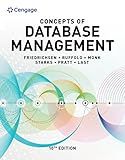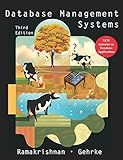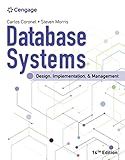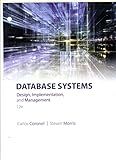Best Database Management Books to Buy in January 2026

Database Design for Mere Mortals: 25th Anniversary Edition



Database Systems: Design, Implementation, & Management



Concepts of Database Management (MindTap Course List)



Database Management Systems, 3rd Edition



Concepts of Database Management



Modern Database Management, Global Edition



Principles of Database Management: The Practical Guide to Storing, Managing and Analyzing Big and Small Data



Database Systems: The Complete Book



Database Systems: Design, Implementation, & Management (MindTap Course List)



Database Systems: Design, Implementation, & Management


To set a limit for an array type field in PostgreSQL, you can use the CHECK constraint when creating the table. The CHECK constraint allows you to specify a condition that must be met for the data in the array field.
For example, if you want to limit the array field to only allow a maximum of 5 elements, you can use a CHECK constraint like this:
CREATE TABLE example_table ( id SERIAL PRIMARY KEY, data_field INTEGER[], CONSTRAINT data_field_limit CHECK (array_length(data_field, 1) <= 5) );
In the above example, the CHECK constraint limits the data_field array to a maximum of 5 elements by using the array_length() function to determine the length of the array. This way, any attempt to insert more than 5 elements into the data_field array will result in a constraint violation error.
By using CHECK constraints in PostgreSQL, you can easily enforce limits and ensure data integrity for array type fields in your tables.
What is the syntax for defining an array type field in PostgreSQL?
To define an array type field in PostgreSQL, you can use the following syntax:
column_name data_type[]
For example, to create a table in PostgreSQL with an array type field:
CREATE TABLE test_table ( id SERIAL PRIMARY KEY, name VARCHAR(50), numbers INTEGER[] );
In this example, the numbers field is defined as an array of integers.
What is the impact of array operations on query performance in PostgreSQL?
Array operations can have a significant impact on query performance in PostgreSQL. When dealing with arrays, some common operations such as array containment, intersection, and unnesting can lead to slower query execution times compared to traditional single-value operations.
One of the reasons for this impact is that array operations can be more resource-intensive, as they require additional processing to handle the multiple values within each array element. This can result in increased CPU and memory usage, leading to slower query performance.
Additionally, array operations can also make it more challenging for the query planner to generate efficient execution plans. This is because arrays can contain varying numbers of elements, making it harder for the planner to estimate the cardinality of the result set accurately. This can lead to suboptimal query plans, resulting in slower query execution times.
To mitigate the impact of array operations on query performance, it is essential to carefully consider how arrays are used in your database design. This may involve normalizing array data into separate tables, using indexes on array columns, and optimizing queries to minimize the use of array operations where possible. Additionally, thorough testing and profiling of queries can help identify potential performance bottlenecks and optimize them accordingly.
How to monitor and maintain the performance of tables with array fields in PostgreSQL?
To monitor and maintain the performance of tables with array fields in PostgreSQL, you can follow these best practices:
- Regularly monitor the performance of queries involving tables with array fields by using PostgreSQL’s built-in monitoring tools such as pg_stat_statements, pg_stat_activity, and pg_stat_user_tables.
- Use EXPLAIN ANALYZE to analyze the query plans of SQL statements that interact with tables containing array fields. This will help identify any potential bottlenecks or performance issues.
- Consider indexing the array fields if they are frequently queried or sorted upon. PostgreSQL supports indexing of arrays, which can significantly improve the performance of array-related queries.
- Analyze and optimize the data model to reduce the size of array fields if it contains a large number of elements. Storing large arrays in a single row can lead to performance degradation due to increased I/O and memory usage.
- Consider normalizing the array fields into separate tables if they are becoming too large or complex. This can help improve data integrity, query performance, and simplify data management.
- Regularly vacuum and analyze the tables with array fields to reclaim unused space and update statistics for query optimization. Use the VACUUM and ANALYZE commands to perform maintenance tasks on the tables.
- Monitor the disk space usage of tables with array fields to ensure that they do not consume excessive storage. Consider implementing a data archiving or partitioning strategy to manage the growth of array data.
By following these tips, you can effectively monitor and maintain the performance of tables with array fields in PostgreSQL.
How to create an array type field in PostgreSQL?
To create an array type field in PostgreSQL, you can use the ARRAY data type along with the desired data type for the elements of the array. Here's an example of how to create a table with an array type field in PostgreSQL:
CREATE TABLE users ( id SERIAL PRIMARY KEY, name VARCHAR(50), emails VARCHAR(100)[] );
In the above example, the "emails" field is defined as an array of VARCHAR(100) elements. You can also specify the size limit for the array elements, or you can use the ANYARRAY data type to create an array field that can hold elements of any data type.
To insert values into the array field, you can use the following syntax:
INSERT INTO users (name, emails) VALUES ('John Doe', ARRAY['john.doe@example.com', 'j.doe@example.com', 'doe.j@example.com']);
You can query the values of the array field using the ARRAY[] syntax:
SELECT id, name, emails FROM users;
This will return the values of the "id", "name", and "emails" fields for all rows in the "users" table.
Overall, creating an array type field in PostgreSQL is a powerful feature that allows you to store multiple values in a single field, making it easier to work with arrays of data in your database.
What is an array type field in PostgreSQL?
In PostgreSQL, an array type field is a column that can store an array of values of a specific data type. This allows you to store multiple values within a single column, making it useful for scenarios where you need to store lists or collections of values. The array type field can store any data type supported by PostgreSQL, such as integers, strings, dates, or custom data types.
